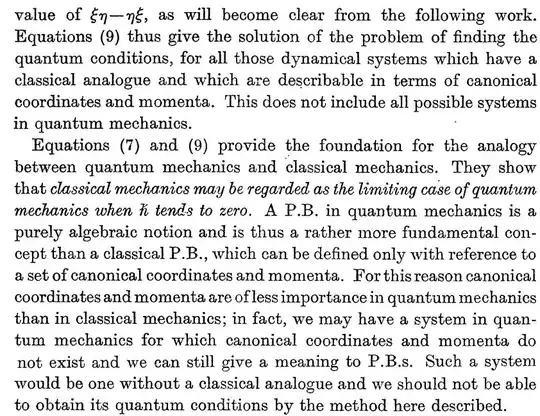1) It is true that not all quantum systems have classical analogues. E.g. if we have a quantum algebra $({\cal A},\ast)$ of Laurent polynomials in an indeterminate $\hbar$, and endowed with an associative star product $\ast$, it might not be meaningful to take the classical limit $\hbar\to 0$.
2a) However on the linked page Dirac makes a slightly different point that involves canonical position and momentum coordinates, cf. below boldfaced excerpts.
[...] dynamical systems which have a classical analogue and which are describable in terms of canonical coordinates and momenta. This does not include all possible systems in quantum mechanics. [...]
[...] we may have a system in quantum mechanics for which canonical coordinates and momenta do not exist and we can still give a meaning to P.B.s. Such a system would be one without a classical analogue [...]
2b) Recall that the first few entries in the dictionary between
$$\tag{0} \text{Quantum Mechanics}\quad\longleftrightarrow\quad\text{Classical Mechanics}$$
read
$$\tag{1} \text{Operator}\quad\hat{f}\quad\longleftrightarrow\quad\text{Function/Symbol}\quad f,$$
$$\tag{2} \text{Commutator}\quad \frac{1}{i\hbar}[\hat{f},\hat{g}] \quad\longleftrightarrow\quad\text{Poisson bracket}\quad \{f,g\}_{PB} , $$
$$ \text{Heisenberg's EOMs}\quad\quad\quad\quad\quad\quad \text{Hamilton's EOMs} $$
$$\tag{3} \frac{d\hat{f}}{dt}~=~\frac{1}{i\hbar}[\hat{f},\hat{H}]+ \frac{\partial\hat{f}}{\partial t}\quad\longleftrightarrow\quad \frac{df}{dt}~=~\{f,H\}_{PB}+ \frac{\partial f}{\partial t} .$$
See also this Phys.SE post.
2c) In a modern language, Dirac is essentially saying (in the above quotes) that if we dequantize a quantum theory, then on the classical side the resulting (possibly degenerate) Poisson manifold may not be a symplectic manifold, or even a regular$^1$ Poisson manifold.
Recall that the Darboux's theorem, which guarantee the existence of Darboux/canonical coordinates (in each sufficiently small neighborhoods) does not hold for (singular$^2$) Poisson manifolds.
2d) One simple counterexample is the $su(2)$ Lie algebra
$$\tag{4} [\hat{J}^I,\hat{J}^J] ~=~i\hbar\varepsilon_{IJK}\hat{J}^K $$
of angular momentum operators, which leads to a singular Poisson manifold $\mathbb{R}^3$ with Poisson bracket
$$\tag{5} \{J^I,J^J\}_{PB} ~=~\varepsilon_{IJK}J^K. $$
The symplectic leaves are concentric 2-spheres. The symplectic leaf $\{0\}$ at the origin is singular. There does not exist Darboux/canonical coordinates in a neighborhood of the origin.
--
$^1$ A regular Poisson tensor has constant rank. A singular Poisson tensor can have rank jumps. A Poisson structure of maximal rank is a symplectic structure.
$^2$ There exists a generalized version of Darboux's theorem for regular Poisson manifold where Darboux neihborhoods contains position, momentum and casimir coordinates.
